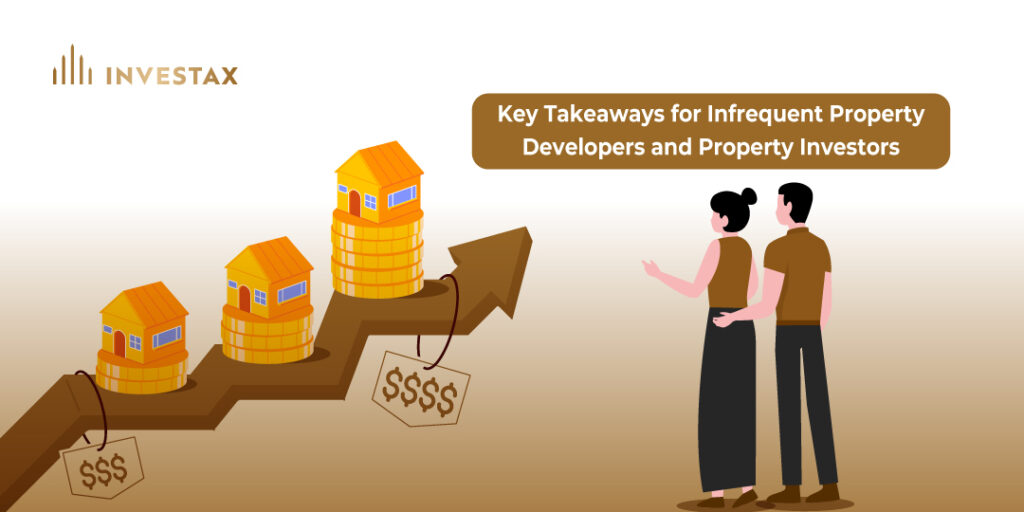Jim and Maria, a married couple, decided to invest in property with a long-term vision. In Year 1, they purchased a block of land with the intention of building two townhouses and keeping them as long-term rental investments.
However, rising interest rates during the construction period significantly impacted their financial position. By the time they completed construction and obtained the occupancy certificate in Year 3, they realised they could not afford to retain the property while also maintaining their existing home. As a result, they decided to sell the newly completed property within 1-2 months of receiving the occupancy certificate.
During their initial meeting with Investax, Jim and Maria had several capital gains tax (CGT) and ownership structure queries. They wanted to ensure compliance with tax laws while also optimising their tax position. Below, we outline their key questions and our expert insights.

Q1: Can you still qualify for the 50% Capital Gains Tax (CGT) discount if you sell a newly built property within two months of receiving the occupancy certificate?
Answer: The eligibility for the 50% Capital Gains Tax (CGT) discount depends on several factors.
- Capital vs Revenue Account:
- Newly built properties are generally treated as capital assets (capital account) rather than trading stock (revenue account) unless they were developed with the intention to sell for a profit.
- If the property is held on the capital account, it may qualify for the CGT discount, whereas properties held on the revenue account (i.e., treated as a business activity) would be taxed as ordinary income without access to the CGT discount.
- 12-Month Holding Period:
- For CGT discount eligibility, the key consideration is whether the land was purchased at least 12 months before the sale date—not whether 12 months have passed since the occupancy certificate was issued.
- In Jim and Maria’s case, they purchased the land in Year 1 and sold the completed property in Year 3, well beyond the 12-month requirement.
- GST Considerations:
- Jim and Maria never registered for GST or claimed GST credits on construction costs because their original intent was to keep the property as a long-term investment.
- This reinforces that their project is treated on the capital account, further supporting their eligibility for the 50% CGT discount.
Important Consideration: If the ATO determines that the property was developed with an intention to sell for a profit, rather than as an investment, it could be treated as ordinary income (revenue account) instead of a capital gain. In that case, the CGT discount would not apply.
Q2: Will CGT be applied separately to the land and the building?
Answer: No, Jim and Maria’s land and building are treated as a single asset for CGT purposes.
- CGT applies to the entire property when it is sold, rather than treating the land and the newly constructed dwelling separately.
- This means that they do not need to calculate separate capital gains for the land and the house. Instead, their cost base includes both the land cost and the construction costs.
Q3: How does the choice of ownership structure—such as holding a newly constructed property in an SMSF, family trust, or partnership—impact tax treatment and eligibility for the 50% CGT discount?
Answer: The ownership structure can impact the CGT discount and tax treatment:
✅ Individuals, Trusts & Partnerships – Eligible for the 50% CGT discount, as long as the property/Land was owned for more than 12 months before the sale.
✅ SMSF (Self-Managed Super Fund) – Eligible for a 33.33% CGT discount (instead of 50%). However, you may not be able to alter the nature of the original property if you have loan against your SMSF property.
🚫 Company Structure – No CGT discount applies. Companies must pay tax on the full capital gain at the corporate tax rate.
Since Jim and Maria owned the property in their individual names, they were eligible for the full 50% CGT discount.
Q4: Are we required to pay GST since we are selling the property immediately after completing construction?
Answer: Since Jim and Maria never intended to sell the property, they did not register for GST and never claimed GST credits on the construction costs. GST obligations typically apply when you are actively engaged in a property development business. Their intention and actions clearly indicate that they were constructing the property as a long-term investment. As a result, they are not required to pay GST on the sale.
- GST typically applies to new residential properties when sold by property developers or businesses. However, since Jim and Maria were not developers and intended to hold the property as an investment, they were advised not to claim GST credits on construction costs.
- If they had claimed GST credits, the sale of the property may have been subject to GST under the margin scheme, or they may have needed to remit 1/11th of the sale price as GST.
By following Investax’s advice and not claiming GST credits, they avoided potential GST implications on the sale.
Q5: How can we ensure our sale is treated as a capital gain and not business income?
To strengthen their position as investors rather than property developers, Jim and Maria ensured that:
✅ Their original intent was to hold the property as a rental investment, and they could demonstrate this intent through investment plans and discussions with their accountant.
✅ They never engaged in frequent property transactions, meaning this sale was an isolated case rather than a business activity.
✅ They only sold due to financial hardship caused by rising interest rates, which was a change in circumstances rather than a pre-planned profit-making scheme.
✅ They did not claim GST credits for construction costs, reinforcing that they were not conducting a taxable enterprise.
Outcome: Since they held the property on the capital account, the CGT discount applied, and their sale was not treated as a business income transaction.
Final Tax Outcome for Jim & Maria
✔️ They qualified for the 50% CGT discount as they held the land for more than 12 months.
✔️ They had no GST obligations since they never claimed GST credits on construction.
✔️ Their sale was treated as a capital gain rather than business income, minimising tax liability.
🚫 Their ownership structure (individual names) was not optimal. They could have maximised tax benefits through flexible income distribution if they had structured the property ownership under a trust.

Key Takeaways for Infrequent Property Developers and Property Investors
💡 Holding land for more than 12 months qualifies you for the 50% CGT discount, even if you sell shortly after construction is completed.
💡 Owning the property in a trust, partnership, or as an individual allows access to CGT discounts, while companies do not qualify for any discount.
💡 If your original intent was to hold the property as an investment, ensure you do not claim GST credits, as this can trigger GST obligations on sale.
💡 A change in financial circumstances (e.g., rising interest rates) can justify a sale without triggering revenue account treatment.
💡 Proper structuring from the beginning can save significant tax liabilities when exiting an investment.
Conclusion
Jim and Maria’s case highlights the importance of proper tax planning and structuring in property development. Many small property investors may find themselves in similar situations where unforeseen financial changes force them to sell earlier than planned.
By understanding how CGT works, how ownership structure affects tax treatment, and how GST obligations arise, investors can make informed decisions and avoid unnecessary tax liabilities.
If you are considering property development and need tailored tax advice, Investax can help you structure your investment efficiently and ensure compliance with tax regulations.
Reference – Building and construction – residential premises



